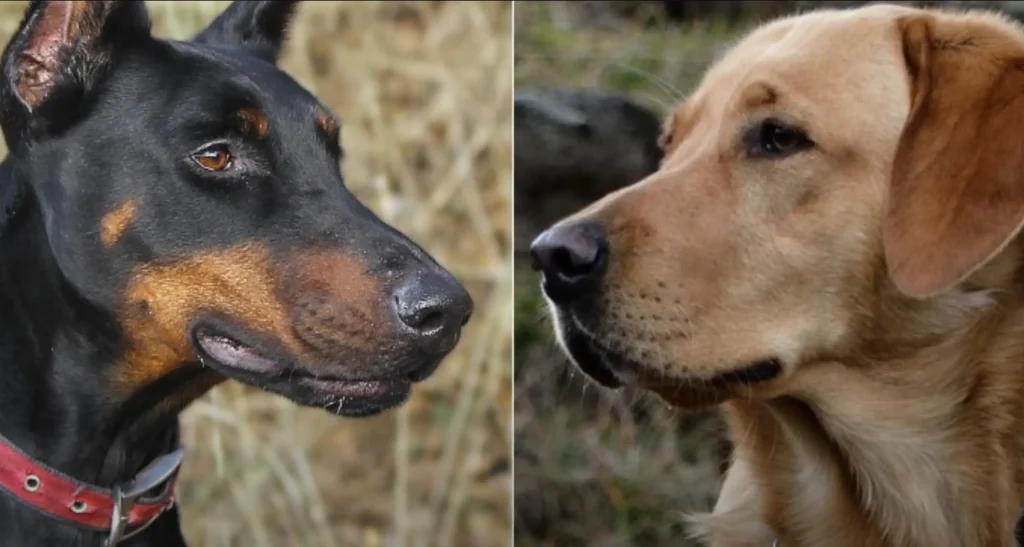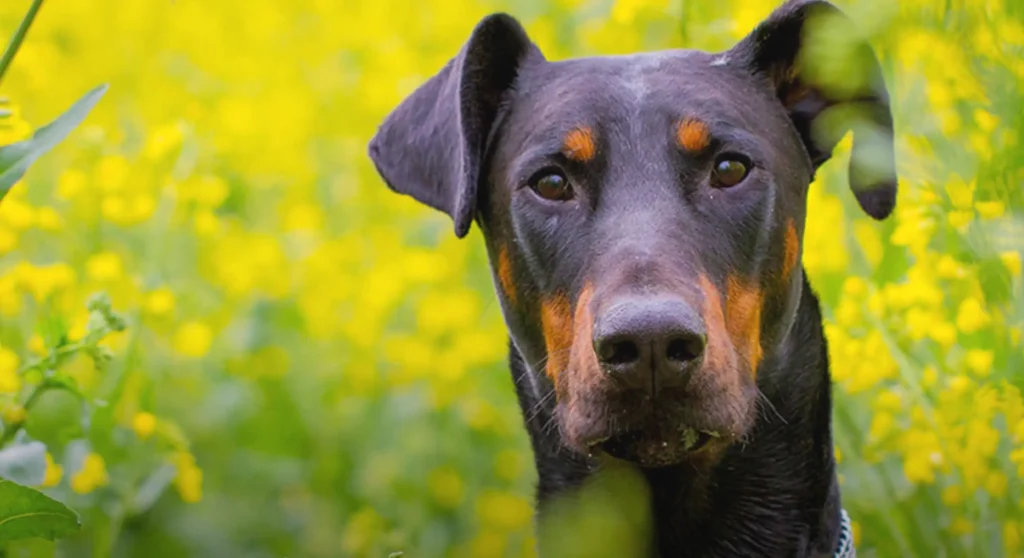When contemplating adding a four-legged companion, the Doberdor—a blend of Doberman Pinscher prowess and Labrador Retriever charm—might be the energetic and devoted pet you’ve been looking for.
As a professional observer of canine crossbreeds, you’ll find that this mix can offer a unique balance of intelligence, loyalty, and a zest for life that is hard to match.
You’ll need to consider whether you have the space and time to accommodate their exercise needs, as they are not the type to be content with a sedentary lifestyle.
The Doberdor’s robust build and alert demeanor hint at their protective nature, but what does this mean for your family dynamics and daily routines?
Stay tuned, as we’re about to explore the intricacies of their temperament and the nuances of their care to help you determine if this hybrid could be the perfect addition to your home.
- Noise Level
- Energy
- Sociability
- Trainability
- Care
- Health
Overall
Summary
The Doberdor is a moderately noisy and sociable breed with high energy levels, making them suitable for active lifestyles. They are relatively easy to train and require moderate care, while generally maintaining good health.
Doberdor: Traits, Temperament, and Care Guide
Doberdors, a blend of Doberman Pinscher and Labrador Retriever traits, exhibit a complex temperament that combines loyalty and protectiveness with a need for consistent training and socialization.
As a large breed, they thrive on exercise and mental stimulation. A comprehensive care guide emphasizes early socialization and obedience training to mitigate potential health problems.
Your Doberman Labrador mix’s well-being hinges on fulfilling these robust care requirements.
Exploring the Characteristics of the Doberdor
Building on the foundation of their care requirements, it’s crucial to understand the specific characteristics of Doberdors that contribute to their unique behavioral profile and physical needs.
| Trait | Description | Relevance |
|---|---|---|
| Size | Large (60-100 lbs, 24-28 inches) | Suited for homes with space |
| Coat | Short, dense, needs regular grooming | Maintenance consideration |
| Exercise Needs | High, requires ample activity | Not ideal for apartment living |
| Health Concerns | Prone to hip/elbow dysplasia, Wobbler’s | Regular vet check-ups necessary |
| Social Behavior | Friendly with children/pets if socialized | Essential for family integration |
Doberdor: A Comprehensive Profile and Guide
As you consider adding a Doberdor to your family, it’s essential to understand their unique profile that blends the Doberman Pinscher’s vigilance with the Labrador Retriever’s affability. Studies indicate that their mixed lineage contributes to a robust genetic makeup, yet they may inherit health issues such as hip dysplasia and heart conditions prevalent in their parent breeds.
Proper socialization and consistent training are non-negotiable for Doberdors, ensuring they develop into well-adjusted and obedient companions.
Everything You Need to Know
To fully understand the Doberdor, a mix of Doberman Pinscher and Labrador Retriever, it’s essential to delve into their exercise needs, socialization processes, and potential health concerns.
- Exercise Needs:
- High energy; thrives with ample space to run
- Requires multiple walks, interactive play
- Socialization:
- Essential from a young age
- Promotes good behavior with children
- Health Concerns:
- Watch for hip dysplasia, obesity
Discovering the Temperament
Often, Doberdors exhibit a temperament that reflects their lineage, combining the loyalty and protective instincts of a Doberman Pinscher with the intelligence and trainable nature of a Labrador Retriever.
This mixed breed thrives on socialization, vital for nurturing their suitability to coexist well with children.
As an energetic dog, the Doberman Lab mix requires substantial exercise to manage its high prey drive, ensuring it remains balanced and content companion.

Doberdor: Is It a Good Fit for Families?
If you’re considering a Doberdor as your family pet, it’s critical to understand its compatibility with children and home environments.
Evidence suggests their protective instincts, combined with early socialization, can foster a strong bond with family members, creating a safe and playful atmosphere for kids.
However, to ensure a harmonious family dynamic, you must factor in their need for regular exercise and potential health risks inherited from their parent breeds.
Assessing Doberdor’s Compatibility with Families and Kids
When evaluating the Doberdor’s compatibility with family life, it’s crucial to note that while they generally form strong bonds with children, early socialization is imperative to foster safe and positive interactions.
- Family Dogs:
- Labrador Retriever: Affectionate, patient with kids
- Doberman Pinscher: Loyal, protective qualities
- Doberdor Puppy: Needs socialization from a young age
These active hybrids require space and can be excellent guard dogs with proper training.
Doberdor Suitability for Apartments
While some may assume larger dogs are ill-suited for apartment living, Doberdors can thrive in such environments with adequate exercise and mental engagement.
Your Doberman Lab mix’s suitability hinges on meeting high energy demands through daily activity. Early socialization ensures they’re well-behaved neighbors.
If often left alone, consider their space requirements and exercise needs to ensure your Doberdor’s contentment and polite behavior.
Doberdor Obedience Essentials
Early socialization and training are critical for your Doberdor’s development, as studies have demonstrated their effectiveness in preventing aggression and promoting good behavior.
Ensuring they exercise regularly mitigates potential behavioral issues, satisfying their need for mental stimulation given their high intelligence and energy.
Utilize positive reinforcement techniques during obedience training to harness their protective instincts, making them responsive to commands and well-adjusted companions.
Effective Training Strategies for Doberdor
Harnessing the Doberdor’s intelligence and eagerness to please, positive reinforcement techniques emerge as a highly effective strategy for instilling obedience in this crossbreed.
| Training Aspect | Strategy for Doberdors |
|---|---|
| Socialization | Start from a young age |
| Prey Drive Management | Daily walks, fenced-in spaces |
| Consistency | Maintain routine over two years |
As a designer dog combining the Doberman Pinscher and Labrador, the Doberman Lab mix thrives on consistent training and early socialization.
Exercise and Grooming Needs
Doberdors demand significant daily exercise to maintain their robust, muscular frame and prevent potential behavioral issues stemming from pent-up energy. Your Doberman Lab mix needs lots of opportunities to stretch their legs.
While Dobie Lab mixes have short coats that don’t require much grooming, regular maintenance is still necessary. Their coat mightn’t be a double coat, but keeping it clean and healthy is essential.

Health Considerations
As you consider a Doberdor for your home, it’s important to know that they can inherit health issues common to both Dobermans and Labradors, such as hip dysplasia. Regular veterinary check-ups are essential to detect and manage conditions like elbow dysplasia and Wobblers Syndrome early on.
Common Health Issues and Lifespan
While generally robust, Doberdors may inherit a susceptibility to certain health conditions such as elbow dysplasia and Wobblers Syndrome, typical of their Doberman Pinscher and Labrador Retriever lineage. These Doberman Lab mixes also face common health problems like hip dysplasia and may be prone to certain heart problems.
Von Willebrand’s disease can affect them from a young age. Their life expectancy, typically 10-14 years, hinges on inherited health and care from their breeds’ first days.
Alternatives for Doberdor: Discover Similar Breeds
If you’re a fan of the Doberdor, you might also appreciate these breeds, each offering similar traits of loyalty, intelligence, and versatility.
| Similar Dogs | Short Description |
|---|---|
| Labrador Retriever | A friendly and intelligent breed, well-suited for families and various roles. |
| Doberman Pinscher | Known for its loyalty and protective nature, ideal for guarding and companionship. |
| Rottweiler | A strong and confident breed, great for protection and as a loyal family member. |
| German Shepherd | Versatile and intelligent, excelling in work roles and as a companion. |
| Boxer | Energetic and playful, known for its strong build and protective instincts |
Is Doberdor the Right Pet for You?
Determining whether a Doberdor suits your lifestyle requires careful consideration of its adaptability to apartment living, tolerance for solitude, and various weather conditions.
This Doberman Lab mix dog, with roots in both Labrador Retriever dog and Doberman lineages, is a large breed known for its need to stay active.
As highly sensitive working dogs, Doberdors thrive with attentive owners who understand their dietary needs and provide a sense of belonging.
Conclusion
In conclusion, the Doberdor is like a well-oiled machine, merging the Doberman’s vigilance with the Labrador’s geniality.
This breed thrives on regular exercise and mental stimulation, perfect for an active family.
Ensure you’re equipped for their grooming and health needs, backed by regular vet visits.
If your lifestyle matches their vigor and you’re committed to training, the Doberdor could be an incomparable companion, blending brawn with a big heart.
Choose wisely; they’re a lifelong commitment.
Frequently Asked Questions
Are Doberman Lab Mix Good Dogs?
Doberman Lab mixes have a balanced temperament, often blending loyalty and friendliness. They’re large, active dogs requiring regular exercise and early socialization, and their lifespan matches size expectations. Prioritize health screenings and consistent training.
Will a Lab and Doberman Get Along?
You’ll find that a Lab and Doberman can get along, considering each dog’s personality traits, temperament mix, and exercise needs. Effective training and socialization are crucial for family compatibility and meeting behavioral expectations.
What 2 Breeds Make a Doberman?
A Doberman emerges from two breeds: the German Pinscher, with its guarding instincts, and the Greyhound, valued for speed. They embody a blend of Pinscher characteristics and the sleekness from their Greyhound ancestry.
What Are the Facts About Doberdor?
You’re seeking Doberdor facts: they’re sizable, with variable coat colors and a life expectancy mirroring their breed popularity. Their temperament needs consistent training; exercise is essential. Health concerns warrant attention; early socialization and adoption options vary.
